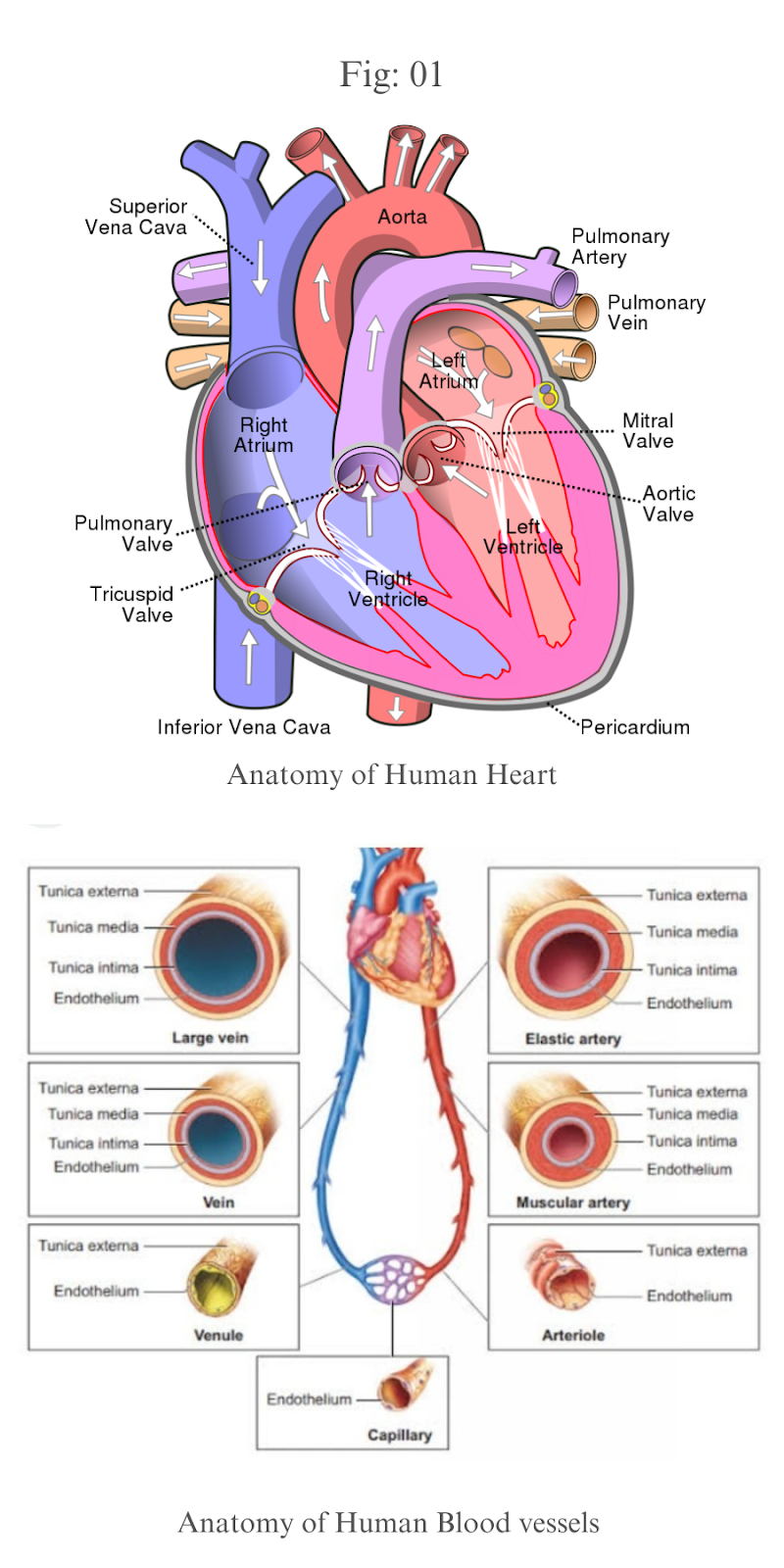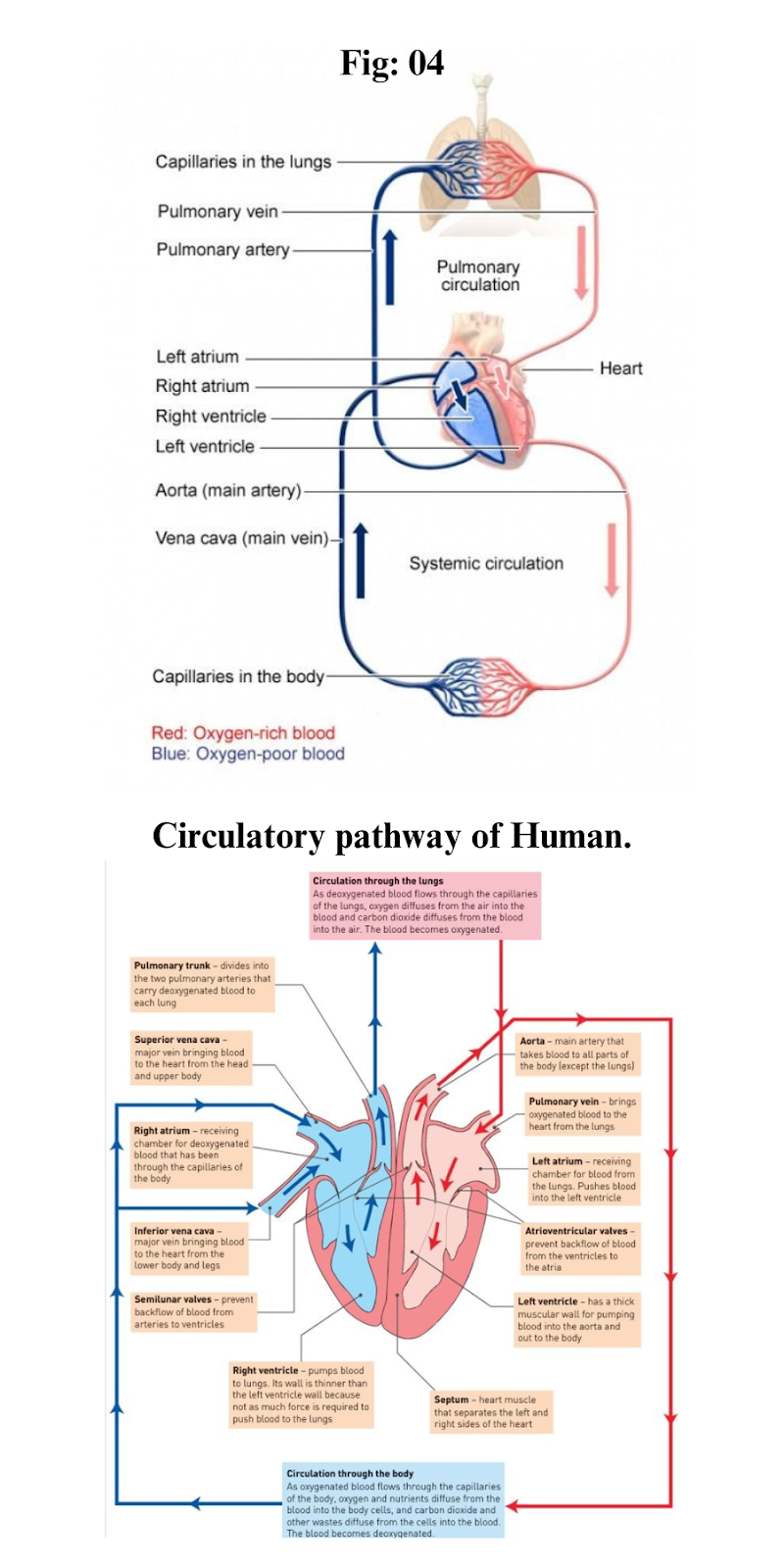The heart and blood are major parts of the circulatory system. All components contribute to oxygen and nutrient delivery throughout your body.
Combined with the cardiovascular system, the circulatory system helps fight off disease, helps the body maintain a normal body temperature, and provides the right chemical balance for the body to achieve homeostasis, or a state of stability among all its systems.
The circulatory system consists of four major components:
heart
arteries
veins
blood
Heart
The heart is a fist-sized organ that pumps blood throughout your body. It's the primary organ of your circulatory system.
Your heart contains four main sections (chambers) made of muscle and powered by electrical impulses. Your brain and nervous system direct your heart’s function.
The heart’s main function is to move blood throughout your body. Your heart also:
Controls the rhythm and speed of your heart rate. Maintains blood pressure.
The heart works with other body systems to control your heart rate and other body functions. The primary systems are:
Nervous system: Your nervous system helps control your heart rate. It sends signals that tell your heart to beat slower during rest and faster during stress.
Endocrine system: Your endocrine system sends out hormones. These hormones tell your blood vessels to constrict or relax, which affects your blood pressure. Hormones from your thyroid gland can also tell your heart to beat faster or slower.
Parts
The parts of the heart are like the parts of a house. Your heart has:
Walls.
Chambers (rooms).
Valves (doors).
Blood vessels (plumbing).
Electrical conduction system (electricity).
Heart walls
Your heart walls are the muscles that contract (squeeze) and relax to send blood throughout your body. A layer of muscular tissue called the septum divides your heart walls into the left and right sides.
Your heart walls have three layers:
Endocardium: Inner layer.
Myocardium: Muscular middle layer.
Epicardium: Protective outer layer.
The epicardium is one layer of your pericardium. The pericardium is a protective sac that covers your entire heart. It produces fluid to lubricate your heart and keep it from rubbing against other organs.
Heart chambers
Your heart is divided into four chambers. You have two chambers on the top (atrium, plural atria) and two on the bottom (ventricles), one on each side of the heart.
Right atrium: Two large veins deliver oxygen-poor blood to your right atrium. The superior vena cava carries blood from your upper body. The inferior vena cava brings blood from the lower body. Then the right atrium pumps the blood to your right ventricle.
Right ventricle: The lower right chamber pumps the oxygen-poor blood to your lungs through the pulmonary artery. The lungs reload blood with oxygen.
Left atrium: After the lungs fill blood with oxygen, the pulmonary veins carry the blood to the left atrium. This upper chamber pumps the blood to your left ventricle.
Left ventricle: The left ventricle is slightly larger than the right. It pumps oxygen-rich blood to the rest of your body.
Heart valves
Your heart valves are like doors between your heart chambers. They open and close to allow blood to flow through.
The atrioventricular (AV) valves open between your upper and lower heart chambers. They include:
Tricuspid valve: Door between your right atrium and right ventricle.
Mitral valve: Door between your left atrium and left ventricle.
Semilunar (SL) valves open when blood flows out of your ventricles. They include:
Aortic valve: Opens when blood flows out of your left ventricle to your aorta (artery that carries oxygen-rich blood to your body).
Pulmonary valve: Opens when blood flows from your right ventricle to your pulmonary arteries (the only arteries that carry oxygen-poor blood to your lungs).
Arteries
The arteries and their function
Arteries carry blood away from the heart.
The artery walls have three layers: tunica intima (inner), tunica media (middle), and tunica externa (outer).
The middle layer is usually the thickest. It’s made up of smooth muscle that changes the size of the artery to regulate blood flow.
There are three main types of arteries. They get smaller and smaller the further they are from the heart.
Elastic arteries
The aorta and pulmonary arteries are the elastic arteries. They receive blood directly from the heart and need to be elastic to accommodate the surge and contraction as blood pushes through with each heartbeat.
The aorta is the body’s most important artery.
Pulmonary arteries take deoxygenated blood from the right ventricle to the lungs. They’re the only arteries that carry deoxygenated blood.
Muscular arteries
The muscular arteries move blood from the elastic arteries through the body. They’re made of smooth muscle, which can expand and contract as blood flows. The femoral and coronary arteries are two examples of muscular arteries.
Arterioles
The smallest arteries are the arterioles, which move blood from the muscular arteries to the capillaries. The capillaries connect the arteries, which take blood from the heart, and the veins, which take blood to the heart.
The number of capillaries in a body system depends on the amount of material exchange. Skeletal muscle, the liver, and the kidney all have a large number of capillaries because their body systems need a lot of oxygen and nutrients. The cornea of the eye is one area that has no capillaries.
Veins
The veins and their function
The blood moves back to the heart through veins.
The blood travels from the capillaries into the venules, which are the smallest veins. As the blood moves closer to the heart, the veins get larger and larger.
Like the arteries, veins have walls made up of layers called the tunica intima, tunica media, and tunica externa. There are some important differences between the arteries and veins:
In veins, the walls have less smooth muscle and connective tissue.
The walls of veins are thinner than artery walls.
Veins have less pressure and can hold more blood than arteries.
At any time, about 70 percentTrusted Source of the body’s total blood supply is in the veins.
Valves
The veins include valves, small pieces of tissue which keep blood flowing in the right direction.
The valves in the medium and large veins keep the blood flowing towards the heart. In the arms and legs, these valves make sure gravity doesn’t pull blood in the wrong direction.
There are four valves in the heart.
The tricuspid valve separates the right atrium from the right ventricle. The mitral valve, or bicuspid valve, separates the left atrium from the left ventricle.
The remaining two valves are the semilunar valves. The pulmonic valve, or pulmonary valve, separates the pulmonary artery from the right ventricle. The aortic valve separates the aorta and the left ventricle.
Blood
The blood and its function
Blood is the transport medium of nearly everything within the body. It moves hormones, nutrients, oxygen, antibodies, and other important things needed to keep the body healthy.
The blood has four main components.
Plasma
About 55 percent of the blood is plasma. Plasma is what makes blood liquid.
Plasma moves blood cells through the body by way of the circulatory system. It also carries hormones, nutrients, antibodies, and waste products.
Plasma is made up of:
water
salts
sugar
fat
protein
Red blood cells
Red blood cells, also called erythrocytes, make up about 40 to 45 percent of the blood’s volume. These cells have no nucleus, which means they can easily change shape as they move through the body’s arteries and veins.
Red blood cells contain a protein called hemoglobin. It carries oxygen from the lungs to the rest of the body and returns carbon dioxide to the lungs, where it’s exhaled.
White blood cells
White blood cells, also called leukocytes, make up just 1 percent of the blood. They protect the body from infection.
There are five major types of white blood cells.
Most white blood cells are neutrophils, which live for less than 1 day. Neutrophils are the body’s immediate response team.
Types of lymphocytes include B lymphocytes (B cells) and T lymphocytes (T cells). B lymphocytes make antibodies, while T lymphocytes regulate other immune cells and target infected cells and tumors.
The other major types are basophils, eosinophils, and monocytes.
Platelets
Platelets, also called thrombocytes, are cell fragments.
Platelets are essential for blood clotting. They stick to an injured blood vessel lining to provide the basis for a clot. This stops bleeding and promotes healing.
Circulatory System
Oxygen enters the bloodstream through tiny membranes in the lungs that absorb oxygen as it’s inhaled. As the body uses oxygen and processes nutrients, it creates carbon dioxide, which your lungs expel as you exhale.
The circulatory system works thanks to constant pressure from the heart and valves throughout the body. This pressure ensures that veins carry blood to the heart and arteries transport it away from the heart. (Hint: To remember which one does which, remember that “artery” and “away” both begin with the letter A.)
There are three different types of circulation that occur regularly in the body:
Pulmonary circulation. This part of the cycle carries oxygen-depleted blood away from the heart, to the lungs, and back to the heart.
Systemic circulation. This is the part that carries oxygenated blood away from the heart and to other parts of the body.
Coronary circulation. This type of circulation provides the heart with oxygenated blood so it can function properly.
Pulmonary arteries take blood with low levels of oxygen from the right ventricle to the lungs.
Pulmonary veins move oxygen-rich blood from the lungs to the heart’s left atrium.
Systemic arteries take oxygen-rich blood from the left ventricle to the body’s tissues.
Systemic veins move blood with low levels of oxygen from the body’s tissues to the heart’s right atrium.
Coronary arteries take oxygen-rich blood from the aorta to the heart muscle.
Coronary veins move blood with low levels of oxygen from the heart’s myocardium (middle muscular layer) to its right atrium.
Electrical conduction system
Your heart’s conduction system is like the electrical wiring of a house. It controls the rhythm and pace of your heartbeat. It includes:
Sinoatrial (SA) node: Sends the signals that make your heart beat.
Atrioventricular (AV) node: Carries electrical signals from your heart’s upper chambers to its lower ones.
Your heart also has a network of electrical bundles and fibers. This network includes:
Left bundle branch: Sends electric impulses to your left ventricle.
Right bundle branch: Sends electric impulses to your right ventricle.
Bundle of His: Sends impulses from your AV node to the Purkinje fibers.
Purkinje fibers: Make your heart ventricles contract and pump out blood.
Blood Circulation pathway
The right and left sides of your heart work together to make sure blood flows throughout your whole body. Blood flows through your heart in a series of steps. These steps take place in the space of one heartbeat — just a second or two.
On the right side
1. Oxygen-poor blood from all over your body enters your right atrium through two large veins, your superior vena cava and inferior vena cava. These veins drain blood from your upper body and lower body, respectively, and directly empty it into your right atrium.
2. Your tricuspid valve opens to let blood travel from your right atrium to your right ventricle.
3. When your right ventricle is full it squeezes, which closes your tricuspid valve and opens your pulmonary valve.
4. Blood flows through your main pulmonary artery and its branches to your lungs, where it gets oxygen and releases carbon dioxide.
On the left side
1. Oxygen-rich blood travels from your lungs to your left atrium through large veins called pulmonary veins. These veins directly empty the blood into your left atrium.
2. Your mitral valve opens to send blood from your left atrium to your left ventricle.
3. When your left ventricle is full it squeezes, which closes your mitral valve and opens your aortic valve.
4. Your heart sends blood through your aortic valve to your aorta, where it flows to the rest of your body.
Symptoms of poor circulation
There are many symptoms of poor circulation, including:
chest pain
dizziness or feeling faint
shortness of breath
pain, weakness, or numbness in the limbs
swollen limbs
slow or rapid heartbeat, or palpitations
fatigue
The symptoms depend on the type of circulatory condition. As an example, peripheral arterial disease can cause leg and foot problems like:
leg cramping while walking or resting
cold feet or legs
change of leg color
change in toenail color or thickness
loss of hair on the legs and feet
ulcers (sores) that don’t heal on the legs and feet
Conditions that affect the circulatory system
There are several conditions that can affect the heart and circulatory system, including:
Peripheral arterial disease. In peripheral arterial disease, blood flow in the arteries of the legs is restricted. This is usually due to buildup of plaque in the arteries.
Arteriosclerosis. In arteriosclerosis, plaque buildup in the blood vessels becomes calcified and hard. The arteries are less flexible, leading to higher blood pressure, stroke, heart damage, and kidney damage.
Heart attack. During a heart attack, a blockage of blood flow to the heart muscle leads to death of heart muscle tissue. It’s also known as a myocardial infarction.
Angina. In angina, the heart muscle isn’t getting enough blood. This leads to crushing chest pain, fatigue, nausea, and shortness of breath.
Mitral valve conditions. In mitral valve prolapse, mitral valve stenosis, or mitral valve regurgitation, problems with the mitral valve cause oxygenated blood in the heart to flow backward, or blood flow to be slowed down or constricted.
Arrhythmias or dysrhythmias. These terms are both used to describe a heart rate that’s abnormal.
Ischemia. In ischemia, there’s not enough blood flow in the heart, and muscles don’t get enough oxygen.
Aortic disease. This group of conditions affects the aorta. One example is an aortic aneurysm, where the aorta is weak and bulges out.
Extra notes:
Your heart pumps about 2,000 gallons of blood each day. That’s enough to fill an 8-by-10-foot swimming pool.
It beats around 100,000 times daily. In an average life span of almost 79 years, your heart beats nearly 2.9 billion times.








